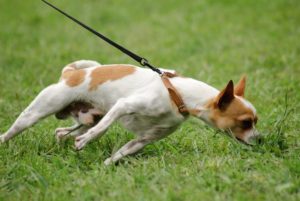Using both a collar and a harness for your dog can be advantageous for a few different reasons. One of the main reasons is that walking small dogs by using a collar can be harmful to them due to most breeds of small dogs being very prone to tracheal collapse. Many owners don’t realize it, but even just slight pulling can cause tracheal collapse. This is especially a cause for concern once the dog is middle aged as trachea problems are more common in older dogs.
Even larger sized dogs often don’t walk well with collars. There aren’t usually any risks associated such as tracheal collapse as larger dogs aren’t prone to it. However, many dogs – large and small – pull on the leash and require a harness to control that behavior. Halti harnesses are one of the best tools for training the desire to pull out of a dog. This is because of the way that Halti harnesses are designed – when the dog pulls against the harness the harness gently directs the dog back towards you. It’s a great deterrent without causing the dog any harm at all.
However, collars still have various uses even for small dogs. Some people prefer having a collar on their dog so if the dog were to get loose people would be able to see that he or she belongs to someone, and tags with contact information can also be attached via the collar. Plus, some owners like to personalize their dog’s collar and attach small charms or pendants to it. So, in this case, the best solution is to use both a collar and a harness. The collar in this way is just for looks or for identification, and the harness is where the leash is attached or where the owner can hold onto if they need to get a grip on their dog. For instance, if the doorbell rings and they have to hold the dog back while answering the door.
 You have to consider that there’re all kinds of different collars, too. Some people use flea collars, no bark collars, and other training collars, as well as collars that work with electronic pet doors which are customized to allow the dog passage through the pet door but not allow anyone else through.
You have to consider that there’re all kinds of different collars, too. Some people use flea collars, no bark collars, and other training collars, as well as collars that work with electronic pet doors which are customized to allow the dog passage through the pet door but not allow anyone else through.
Another useful collar is a break-away collar. These collars can be lifesavers because they prevent strangulation when a dog gets caught on something. This happens all too often, usually while indoors; so they’re great for a bit of peace of mind, particularly when you aren’t home. Even though they’re break-away they can still be used when out on walks – you just put the leash attachment through both of the loops on the collar, and then the dog can’t break away if he pulls on the leash.
So, as useful as a harness is for walking dogs, collars are more versatile and can be absolutely necessary for certain dogs. This is why a lot of owners use both collars and harnesses. They both have different purposes that may not be totally applicable to the other.
